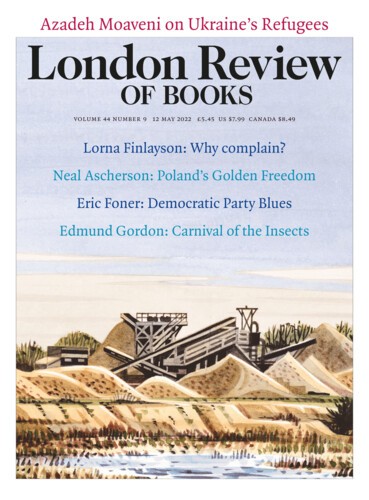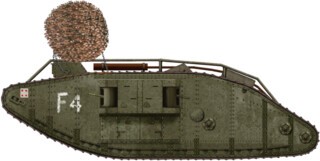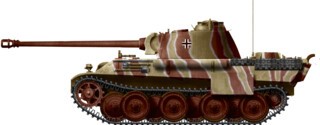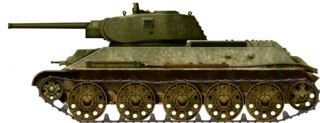In the early summer of 1917, Wilfred Bion, a second lieutenant fresh from the training depot of the Machine Gun Corps, arrived at Wool in Dorset and set off for the army camp at Bovington. The Machine Gun Corps trained recruits in the mechanised warfare brought about by the recent invention of the tank. He saw one almost immediately, broken down in the middle of Bovington Lane. It reminded him, he wrote in his memoir, The Long Weekend, 1897-1919, of his terror as a child in India when confronted by a tiger trap. ‘The day was hot, sunny, still. The queer mechanical shape, immobilised and immobilising, was frightening … I wanted to get away from it. A metallic hammering came from inside; a soldier got out and the day sprang into life again.’
The Bovington Tank Museum preserves several examples of these lozenge-shaped steel hulks. The very first tank, constructed in autumn 1915 after Churchill set up an Admiralty Landship Committee to develop armoured vehicles, is its most prized exhibit. It was known as ‘Little Willie’ (the nickname used by the popular press for the Kaiser’s son). Its successor, the Mark I (the prototype was known as ‘Big Willie’ or ‘Mother’), was the first tank to see action, at the Battle of the Somme in September 1916, and showed some promise in making it through to the German lines. Next to Little Willie in the museum is the Mark II tank, which was mainly used for training. Part of its thick skin has been removed to reveal the cavity within. Most of the space is taken up by a furnace-like engine and weaponry: a miniature cannon and machine gun at either side and their store of ammunition. Tanks carrying only machine guns were known as ‘females’ while those which also carried cannon were ‘males’. There was just enough room for eight men: four to manoeuvre it and four to work the guns. Only the driver and the commander next to him had seats. The heat inside was stifling and the fumes – carbon monoxide, fuel, oil, cordite – overpowering. The tanks were so noisy that the crew communicated by banging their hammers and spanners in code. It was insanely dangerous. The only safety feature was a fire extinguisher the size of a soda siphon.
After being trained as a tank commander, Bion was sent to the Western Front. His first engagement was the Battle of Passchendaele, which began on 31 July 1917. The rendezvous was the ruins of a place near Ypres known as the English Farm. Bion walked his tank onto the road leading to the German front line. That was his job as commander: to walk beside or in front of his tank, pointing out the right direction with a cane (he didn’t get into the tank until it reached its battle position). Very quickly, he found himself in a traffic jam.
I ordered Allen to switch off the engine … Infantry, gunners, ammunition limbers were all stuck in a solid mass … A young staff officer had appeared. ‘What the hell! Is this your tank? Get on, man!’ ‘I can’t sir,’ I started to explain. ‘Drive through them! Push them off the road!’ I realised I had fallen into some peace-time form of manners. ‘This is a war – get on!’ At full power we could only lurch at a mile an hour from shell-hole to shell-hole. The tank began to list to the right … The six-pounder gun filled with mud as it ploughed through, not over, the ground. The flying earth made it impossible for Allen or me to open the front observation flaps … When I tried to use the periscope it was shot off.
Bion’s tank was a sitting duck for the German artillery. He and his crew watched as it subsided inch by inch into the mud; by the time they were ordered back to HQ, only the roof remained visible.
He had better luck at the Battle of Cambrai, on 20 November 1917, where almost four hundred Mark IV tanks were used to achieve a breakthrough so remarkable that the church bells were rung in London to celebrate. ‘The ease and orderliness of the operation after the chaos at Ypres induced a sense of unreality,’ Bion wrote. ‘The battlefield was set out like a diagram; the functions of infantry, gunners and tanks slotted together with such perfection that it seemed as if we were more pieces of a staff officer’s dream than soldiers at war.’ Although it was late autumn, the going was nice and firm. Bion was able to aim his tank straight at its objective: a stronghold in the German trenches fortified with machine guns and thick barbed wire. After smashing through the wire and putting one machine gun out of action, a second opened fire on his left flank. He ordered Allen to load the cannon, but as soon as he opened the breach a spurt of German bullets came up the barrel and started to ricochet around the inside of the tank. Allen collapsed in panic and another member of the crew had to close the breach. ‘“God damn your soul, Allen, you bastard!” I yelled at the cowering boy. I was blubbing with rage and fear myself.’ (It’s not surprising to learn that after the war Bion became a psychoanalyst with a special interest in group dynamics.)
After being debriefed at HQ, he was told he was being recommended for the Victoria Cross. ‘When his tank was put out of action by a direct hit,’ the award citation read, ‘he occupied a section of trench with his men and machine guns and opened fire on the enemy. He moved about in the open, giving directions to other tanks when they arrived, and at one period fired a Lewis gun with great effect from the top of his tank.’ Bion wrote that he
longed to be a VC … but I dreaded it. The worst part of it was facing my crew … They knew what had happened. They did not know – I did – that it was my bungling incompetence that had driven the tank into the strongpoint before time, before I was due … I shouldn’t have been there at all … Ought I to remind them? Or should I keep my mouth shut and get a VC?
In the end, Bion received a DSO, possibly because the ration of medals was reduced after the British lost nearly all their gains at Cambrai to German counter-attacks.
A whiff of Jurassic Park hangs in the air at the tank museum, as if one of these sleeping beasts might wake with a start. Touching the exhibits is permitted; climbing on them is not, although on the day of my visit a man was sitting on a tank talking about the Battle of Kursk in summer 1943. The Kursk battle zone encompassed a huge area, stretching as far west as the border with Ukraine, and involved two million men. The German forces, who were attempting to take the Kursk salient, itself 250 km north to south and 160 km east to west, pitted 2700 tanks, some of them the newly developed Panthers, against 3300 Soviet tanks, mainly T-34s. In size and power, the Panther (44 tons, five crew) was superior to the T-34 (27 tons, four crew), on which it had been modelled – Hitler and the German army had been surprised and impressed during Operation Barbarossa by its firepower and the strength of the armour on its sloped sides. The Panther was better armoured than the T-34 and slightly slower (28 mph against 34 mph). It also used twice as much fuel. The Panther’s advanced engineering made it more complicated to fix when it broke down, which many of the Kursk tanks did because the model had been rushed into use. The T-34 was cheaper to make and repair, and, because it was churned out in large numbers, its production process had been repeatedly streamlined and adjusted. More than 80,000 of them were made and around 45,000 lost during the war. The Battle of Prokhorovka, at which both sides fielded hundreds of tanks, led to huge Soviet losses, but the Germans did not succeed in taking the town. Soon afterwards, Hitler ended the action, moving forces to Italy in the wake of the Allied invasion of Sicily.
Vladimir Putin, whose parents survived the Siege of Leningrad, was brought up in a Soviet Union in which Kursk represented the turning of the tide in the war against Nazism. When he announced a Special Operation in Ukraine, Putin seems to have envisaged a swift victory, but weeks after the invasion, Ukrainian defenders were still holding out in Kharkiv, 140 km south of Prokhorovka, where many T-34s were built until production was moved east to the Urals after German advances in 1941. In the early days of the invasion there were many pictures of Russian tanks broken down beside the road or stuck Passchendaele-style in the mud. Instead of the new and much anticipated T14-Armata, the Russian army is relying on stalwarts such as the T-72, first produced in 1969. Most of Ukraine’s tanks are also T-72s, many dating from the Soviet period. The T-72 at Bovington (42 tons, three crew, top speed 37 mph), which belonged to the East German army, has a five metre snorkel that enables it to cross rivers completely submerged. Upgraded versions of the tank are still being produced. As well as getting stuck in the mud, the Russian T-72s have run out of fuel and broken down as a result of poor maintenance. They haven’t been well supported by air patrols or infantry. According to the Ukrainians, 873 Russian tanks have been destroyed, many by Javelin anti-tank missiles supplied by the US. We have all seen the havoc that 21st-century drones and hand-held missile launchers can wreak on 20th-century armour. The Pentagon says that Ukraine now has more tanks on the ground than Russia.
Images in this piece are from the Online Tank Museum.
Send Letters To:
The Editor
London Review of Books,
28 Little Russell Street
London, WC1A 2HN
letters@lrb.co.uk
Please include name, address, and a telephone number.





